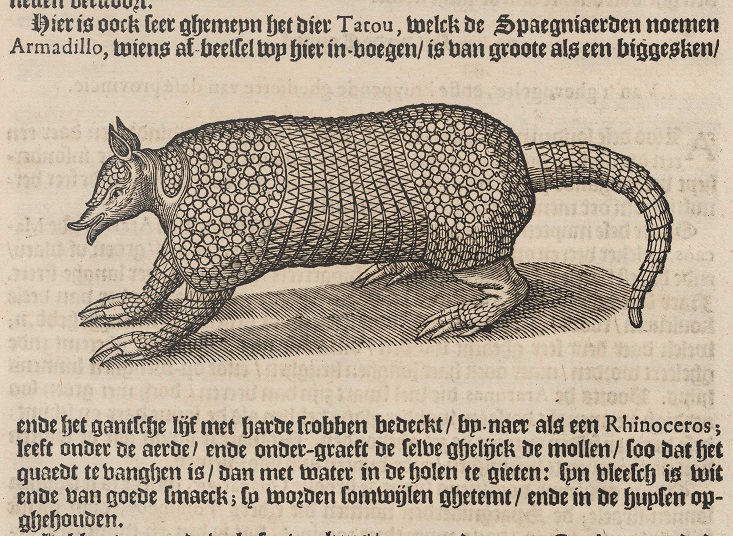Brazil
Niek Zeinstra
This contribution is published in both Dutch and English. You will find the English version below.
| Nummer Koeman’s Atlantes Neerlandici, vol. II | 9850:2B |
| Titel kaart / Titel tekst | BRASILIA / Brasil |
Joan Blaeu beschrijft met zijn teksten het huidige Brazilië en het gouvernement van Bahia. Vanuit de contemporaine bronnen valt te zien welke indrukken op de Westerse wereld een blijvende invloed hebben gehad en hoe deze de perceptie van Brazilië hebben gevormd.
Naast Blaeu schreven ook André de Thevet en Johannes de Laet over de representatie en beeldvorming van de oorspronkelijke volkeren van Brazilië in de zeventiende eeuw. Specifiek focussen de bronnen op drie stammen, waarbij de verdeling er min of meer op neerkomt dat Blaeu zich met name richt op de Petivares, Thevet op de Tupinambá-stam en De Laet op de Maraquites.
Volgens Blaeu was de stam Petivares, in tegenstelling tot andere stammen, minder “barbaars.”. Ze hadden – aldus Blaeu – lichaamsdecoraties, zoals gaten in de lippen, maar waren minder religieus. Ze voerden oorlog tegen de Portugezen, aten mensenvlees en vestigden zich rond Parayba. Blaeu schreef niet alleen over de Petivares, ook over de Tupinambá en de Maraquites. Blaeu schreef over alle drie de stammen, maar heeft hoogstwaarschijnlijk zijn informatie over de Tupinambá en de Maraquites te danken aan de geografen Thevet en De Laet.

Johannes De Laet, Beschrijvinghe van West-Indien (Leiden: Elzevier, 1630), p. 503: the armadillo
Zo geeft de Franse geograaf en reiziger André de Thevet (1516-1590) ons inzicht in de Tupinambá-stam door te focussen op verschillende aspecten van hun levenswijze. Hij bestudeerde in situ lichaamsdecoraties, jachtgewoonten, sociale structuren en eetgewoonten van de Tupinambá. Thevet beschrijft gedetailleerd hoe de Tupinambá hun lichaam versieren met sieraden, verf en mogelijk tatoeages, waarbij deze versieringen niet alleen dienen als expressie maar ook als identiteitsuiting en rituele praktijk. In zijn reisverslag belicht Thevet ook de jachtgewoonten van de Tupinambá, waarbij hij ingaat op wapens, technieken en mogelijke rituele aspecten rondom het jagen. De sociale structuur van de Tupinambá, inclusief stamorganisatie, leiderschapssystemen en besluitvorming, wordt door Thevet belicht, wat inzicht geeft in de sociale dynamiek van de stam. Hij geeft gedetailleerde beschrijvingen van hun dieet, voedselbereidingstechnieken en mogelijke rituelen voor voedselconsumptie. Het noemen van het eten van mensenvlees is een controversieel element dat zowel Thevet als andere auteurs in de vroegmoderne periode vaak benoemen.
Johannes de Laet, die anders dan André de Thevet nooit in Amerika is geweest, beschrijft in zijn werken de fysieke kenmerken, kleding en lichaamsversieringen van de Maraquites. De Laet geeft ook inzicht in de cultuur en tradities van de Maraquites, met aandacht voor rituelen bij belangrijke levensgebeurtenissen, religieuze praktijken en overtuigingen die kenmerkend waren voor hun cultuur.
Suggestie om verder te lezen:
Eakin, M.C. (1997). Brazil: the once and future country. Basingstoke: Macmillan.
| Koeman’s Atlantes Neerlandici, vol. II | 9850:2B |
| Title map / Title text | BRASILIA / Brasil |
In the texts accompanying his map of Brazil, Joan Blaeu describes what is modern-day Brazil and the governorship of Bahia. His contemporaries wrote about Brazil as well. These sources show which colonial views had a lasting effect on public opinion and how they shaped the perception of Brazil.
Besides Blaeu, it was André Thevet (1516-1590) and Johannes de Laet who published representations and depictions of the indigenous peoples of Brazil in the seventeenth century. They focused specifically on three tribes: Blaeu concentrated mainly on the Petivares, Thevet on the Tupinambá, and De Laet on the Maraquites.
Blaeu claimed that, unlike other tribes, the Petivares were less ‘barbaars’ [barbarian]. He wrote that they practised body decoration, such as lip piercing, and they were less religious. They were at war with the Portuguese, they ate human flesh, and they settled in the Paraíba area. Besides the Petivares, Blaeu also wrote about the Tupinambá and the Maraquites. It is likely, though, that he got his information about the Tupinambá and the Maraquites from geographers Thevet and De Laet.
French geographer and traveller André Thevet introduces us to the Tupinambá tribe by focusing on different aspects of their life. He personally spent time with the Tupinambá to study their body decorations, hunting practices, social structures, and eating habits. Thevet details how the Tupinambá decorate their bodies with gems, body paint, and possibly tattoos, not only as a form of self-expression, but also as a display of tribal identity and ritual practice. In his travel journal, Thevet also describes the Tupinambá’s hunting practices, addressing their hunting weapons, techniques, and potential rituals. He sheds light on the Tupinambá’s social structure, including their tribal hierarchy, leadership systems, and decision-making processes. This gives us an understanding of the tribe’s social dynamic. He provides detailed descriptions of their diet, food preparation techniques, and possible rituals for food consumption. Eating human flesh is a controversial element that both Thevet and other early-modern authors have a tendency to mention.
Johannes de Laet, who – unlike André Thevet – never travelled to America himself, describes the Maraquites’ physical appearance, their clothing, and their body decorations. De Laet also provides an insight into the culture and traditions of the Maraquites, addressing their rituals for important life events, their religious practices, and the beliefs that were typical of their culture.
Further reading:
Eakin, M.C. (1997). Brazil: the once and future country. Basingstoke: Macmillan.
